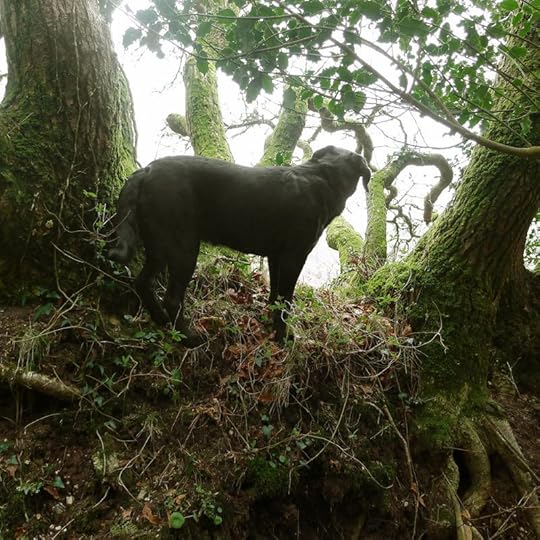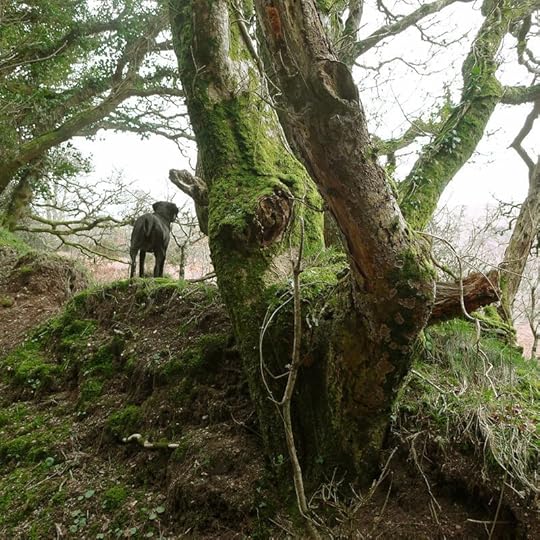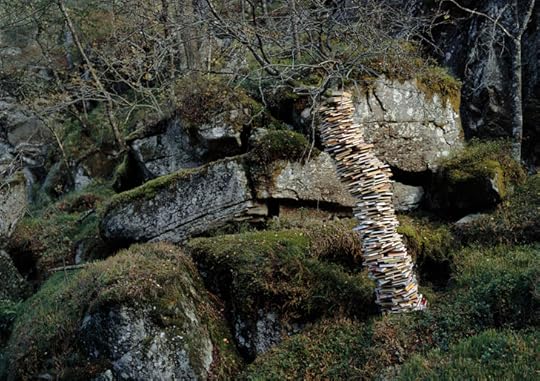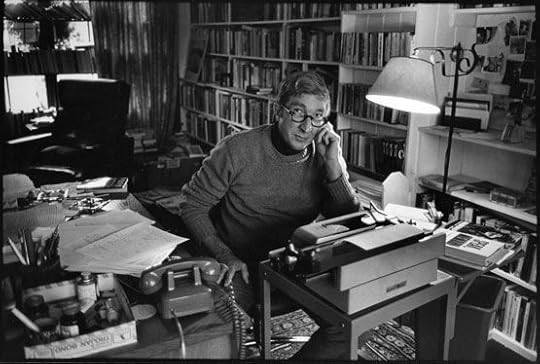Terri Windling's Blog, page 194
April 10, 2013
Rituals of beginning, 2
From an interview with Toni Morrison in The Paris Review:
"Recently I was talking with a writer who described something she did
whenever she moved to her writing table. I don't remember exactly what
the gesture was -- there is something on her desk that she touches
before she hits the computer keyboard -- but we began to talk about the
rituals one goes through before beginning to write.
"I, at first, thought I didn't have a ritual, but then I remembered
that I always get up and make a cup of coffee while it is still dark --
it must be dark -- and then I drink the coffee and watch the light come.
And she said, well, that's a ritual. And I realized that for me, this
ritual comprises my preparation to enter a space that I can only call
nonsecular....
"Writers all devise ways to approach that place where they expect to make contact, where they become the conduit, or where they engage in this mysterious process. For me, light is the signal in the transition. It's not being in the light, it's being there before it arrives. It enables me, in some sense."
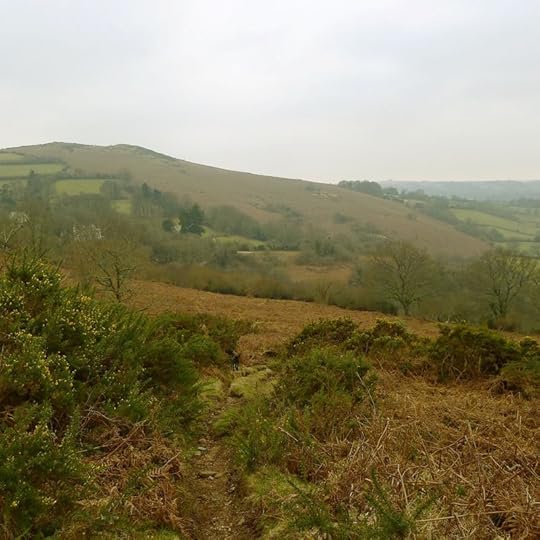 A previous post on pre-dawn writing rituals can be found here. (And I should mention that posting times might be a bit erratic this week until we get our Internet service problem sorted out.)
A previous post on pre-dawn writing rituals can be found here. (And I should mention that posting times might be a bit erratic this week until we get our Internet service problem sorted out.)
April 9, 2013
Quick announcement
We're continuing to have Internet service problems. I'll put up today's longer post as soon as the Trickster Gods of Cyberspace calm down and stop bouncing me offline. Here's Tilly the Vampire Dog to entertain you in the meantime.
We're continuing to have Internet service problems. I...
We're continuing to have Internet service problems. I'll put up today's longer post as soon as the Trickster Gods of Cyberspace calm down and stop bouncing me offline. Here's Tilly the Vampire Dog to entertain you in the meantime.
Rituals of beginning
From dancer/choreographer Twyla
Tharp's The Creative Habit:
"I begin each day of my life with
a ritual: I wake up at 5:30 a.m., put on my workout clothes, my leg
warmers, my sweatshirts, and my hat. I walk outside my Manhattan
home, hail a taxi, and tell the driver to take me to the Pumping Iron
gym at 91st Street and 1st Avenue, where I work out for two hours.
The ritual is not the stretching and weight training I put my body
through each morning at the gym; the ritual is the cab. The moment I
have told the driver where to go, I have completed the ritual.
"It's a simple act, but doing it
the same way each morning habitualizes it -- makes it repeatable,
easy to do. It reduces the chance that I would skip it or do it
differently. It is one more item in my arsenal of routines, and one
less thing to think about.
"Some people might say that simply
stumbling out of bed and getting into a taxicab hardly rates the
honorific 'ritual.' It glorifies a mundane act that anyone can
perform.
"I disagree. First steps are hard;
it's no one's idea of fun to wake up in the dark every day and haul
one's tired body to the gym. Like everyone, I have days when I wake
up, stare at the ceiling, and ask myself, Gee, do I feel like working
out today? But the quasi-religious power I attach to this ritual
keeps me from rolling over and going back to sleep.
"A ritual, the Oxford English
Dictionary tells me, is 'a prescribed order of performing
religious or other devotional service.' All that applies to my
morning ritual. Thinking of it as a ritual has a transforming affect
on the activity.
"It's vital to establish some
rituals -- automatic but decisive patterns of behavior -- at the
beginning of the creative process, when you are most at peril of
turning back, chickening out, giving up, or going the wrong way.
"Turning something into a ritual
eliminates the question, Why am I doing this? By the time I give the
taxi driver directions, it's too late to wonder why I'm going to the
gym and not snoozing under the warm covers of my bed. The cab is
moving. I'm committed."
What rituals do you use to start your workday, or to help you cross over from the everyday world into the time-bending realm of creavity? This is a discussion I keep returning to (we've spoken about it before here and here) as each season brings new work and health challenges, and as I strive to use my time and energy (my spoons) as wisely as I can. If you participated in the previous discussions, have your rituals changed in the intervening year? Or, perhaps, are you one of those contrary creative souls for whom the very idea of a ritual or routine is anathema? What helps, what hinders, when you're at your desk or in your studio, and it's time to begin?

My apologies for the late post today; we're having difficulties with our Internet service. Images above: These early morning photographs come from a blessed day of sun this past weekend, the landscape glowing, saturated with rain.
April 7, 2013
Tunes for a Monday Morning
Today's tunes come from the outrageously talented Josh Flowers and The Wild, a five-piece alt-folk and blues band from London. These lads are just blindingly good.
Above: "Nickajack Cave," from their first EP, The Observatory Sessions (recorded live last year at the old Radcliffe Observatory in Oxford).
Below: "Poor Boy Blues," from the same EP.
Last:
"Rolling Through," a lovely song from their new EP, Young Bones. Banjo, cello, fine harmonies, and Flowers' gorgeous lyrics. <happy sigh>
I you want more, go here for the music video for "Cold," off the new EP.
April 4, 2013
From the archives: Poetry Pie
I love April not only because it's the the month when wild daffodils bloom in our woods, but also because it's National Poetry Month, when poetry, too, blooms everywhere...and that's why I've chosen this particular piece from the archives to re-post today. It comes from the spring of 2010...with a small addition....
Some years ago a friend of mine here in the village had a birthday party
for which she requested that her guests bring pies to share. I thought
about bring a shoofly pie
from my Pennsylvania Dutch childhood -- but not only is this something
of an acquired taste, it also would have required me to actually cook...and
I'm not much of a cook, and even less of a baker, at the best of times.
I solved the problem by bringing a Poetry Pie instead: lining a glass
pie plate with a "crust" of autumn leaves, filled with acorns, small pines cones, bits of lace and sundries and small scrolls of
paper tied in red ribbon: each little scroll containing a poem hand-written in gold ink. Each party guest could then choose a scroll from the pie (I'd made sure that there were enough for all), and whatever poem they found inside "belonged" especially to them. It was food for the spirit, the sweet taste of language, art and dessert rolled into one.
All these years later, I still see poems from that pie pinned to bulletin boards all around the village....
Since I can't create a Poetry Pie for each of you, here's a "virtual pie" from Myth & Moor to wish you a Happy National Poetry Month...
Pick a number, any number. Follow the link, and you'll find your poem.
1 2 3 4 5 6 7 8 9 10 11 12 13 14 15 16
17 18 19 20 21 22 23 24 25 26 27 28 29 30
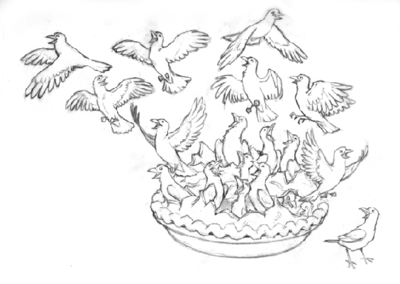
The color illustrations above come from Walter Crane's Sing a Song of Sixpence, published in 1909. The charming blackbird drawing is by Scott Gustafson. For more about pie, visit our daughter Victoria's Cherries and Chocolate blog. (Unlike me, she can cook, and is a professional pastry chef.)
April 3, 2013
From the archives: Trading Stories
Jhumpa Lahiri, one of my favorite writers, has a gorgeous piece in the New Yorker Magazine: "Trading Stories: Notes from an Apprenticeship." In this short memoir, Lahiri describes her journey from book-loving child to Pulitzer Prize-winning author, and examines the mindset that turns some of us into writers despite every other intention.
I found "Trading Stories" of particular interest because, despite our vastly different family backgrounds, Lahiri and I have one thing in common: we were both children who wrote incessantly in youth...and who then stopped writing (for a time) in young adulthood, channelling our creativity into other areas instead.
She writes: "As I grew into adolescence and beyond, however, my writing shrank in what seemed to be an inverse proportion to my years. Though the compulsion to invent stories remained, self-doubt began to undermine it, so that I spent the second half of my childhood being gradually stripped of the one comfort I’d known, that formerly instinctive activity turning thorny to the touch. I convinced myself that creative writers were other people, not me, so that what I loved at seven became, by seventeen, the form of self-expression that most intimidated me. I preferred practicing music and performing in plays, learning the notes of a composition or memorizing the lines of a script..."
For me, too, the writing impulse was channeled into theater work, and I actually entered university intending to major in theater -- an intention so ill-suited to my nature that it seems little short of insane to me now. Fortunately it wasn't too long before I found my way back to my true vocation.
Lahiri explains her own detour away from her proper vocation with the following words:
"For much of my life, I wanted to be other people; here was the central dilemma, the reason, I believe, for my creative stasis. I was always falling short of people’s expectations: my immigrant parents’, my Indian relatives’, my American peers’, above all my own. The writer in me wanted to edit myself. If only there was a little more this, a little less that, depending on the circumstances: then the asterisk that accompanied me would be removed. My upbringing, an amalgam of two hemispheres, was heterodox and complicated; I wanted it to be conventional and contained. I wanted to be anonymous and ordinary, to look like other people, to behave as others did. To anticipate an alternate future, having sprung from a different past. This had been the lure of acting—the comfort of erasing my identity and adopting another. How could I want to be a writer, to articulate what was within me, when I did not wish to be myself?"
This too I can relate to. As a child growing up with a mentally ill parent, tossed between various relatives, all I wanted in adolescence was to be ordinary, from an ordinary family. The very things in my background that give me strength and compassion as an adult, both as a woman and as a writer, were the things things that mortified me in adolescence; and I was no more willing to "alchemize" them into prose than I was to strip in public.
"It was not in my nature to be an assertive person," Lahiri continues. "I was used to looking to others for guidance, for influence, sometimes for the most basic cues of life. And yet writing stories is one of the most assertive things a person can do. Fiction is an act of willfulness, a deliberate effort to re-conceive, to rearrange, to reconstitute nothing short of reality itself. Even among the most reluctant and doubtful of writers, this willfulness must emerge. Being a writer means taking the leap from listening to saying, 'Listen to me.'
"This was where I faltered. I preferred to listen rather than speak, to see instead of be seen. I was afraid of listening to myself, and of looking at my life."
I can't help but wonder how many other young writers have likewise faltered in making that step -- or, worse, have stopped in their tracks altogether. It takes courage to write, and to expose oneself. And to be oneself. But then, all art takes courage.
And stubbornness.
And foolishness.
Stirred together with a teaspoon of talent, a tablespoon of craft (or maybe it's the other way around?), a heaping cup of plain hard work, and a pinch of luck.
 Art above: Book sculptures by Norwegian installation artist Rune Guneriussen, whose whimsical light sculptures were featured in this previous post. In addition to Jhumpa Lahiri's essay, "Trading Stories," I also recommend Tea Obreht's short memoir "High-School Confidential," published in the same issue of The New Yorker. And the wonderful books of both authors.
Art above: Book sculptures by Norwegian installation artist Rune Guneriussen, whose whimsical light sculptures were featured in this previous post. In addition to Jhumpa Lahiri's essay, "Trading Stories," I also recommend Tea Obreht's short memoir "High-School Confidential," published in the same issue of The New Yorker. And the wonderful books of both authors.
April 2, 2013
From the archives: The Writing Life
"It wasn't that I
couldn't write. I wrote every day. I actually worked really hard at
writing. At my desk by 7 A.M., would work a full eight and more.
Scribbled at the dinner table, in bed, on the toilet, on the No. 6
train, at Shea Stadium. I did everything I could. But none of it worked.
My novel, which I had started with such hope shortly after publishing
my first book of stories, wouldn't budge past the 75-page mark. Nothing I
wrote past page 75 made any kind of sense. Nothing. Which would have
been fine if the first 75 pages hadn't been pretty damn cool. But they
were cool, showed a lot of promise. Would also have been fine if I could
have just jumped to something else. But I couldn't. All the other
novels I tried sucked worse than the stalled one, and even more
disturbing, I seemed to have lost the ability to write short stories. It
was like I had somehow slipped into a No-Writing Twilight Zone and I
couldn't find an exit. Like I'd been chained to the sinking ship of
those 75 pages and there was no key and no patching the hole in the
hull. I wrote and I wrote and I wrote, but nothing I produced was worth a
damn.
"Want to talk about stubborn? I kept at it for five straight
years. Five damn years. Every day failing for five years? I'm a pretty
stubborn, pretty hard-hearted character, but those five years of fail
did a number on my psyche. On me. Five years, 60 months? It just about
wiped me out. By the end of that fifth year, perhaps in an attempt to
save myself, to escape my despair, I started becoming convinced that I
had written all I had to write, that I was a minor league Ralph Ellison,
a Pop Warner Edward Rivera, that maybe it was time, for the sake of my
mental health, for me to move on to another profession, and if the
inspiration struck again some time in the future...well, great. But I
knew I couldn't go on much more the way I was going. I just couldn't.... So I put the manuscript away. All the hundreds of failed pages, boxed
and hidden in a closet. I think I cried as I did it. Five years of my
life and the dream that I had of myself, all down the tubes because I
couldn't pull off something other people seemed to pull off with
relative ease: a novel. By then I wasn't even interested in a Great
American Novel. I would have been elated with the eminently forgettable
NJ novel."
-- from "Becoming a Writer" by Junot Díaz, who went on to finish his novel and win the Pulitzer Prize. Read the rest of this wonderful article here. His books are terrific too.
 Images above: "Fairy Scribe" and "Small Fairy with Brush" by Alan Lee.
Images above: "Fairy Scribe" and "Small Fairy with Brush" by Alan Lee.
From the archives: Tools of the Trade
I'm still recovering from a prolonged bout of flu (and looking after Howard, who is in the thick of it now). I also have a great deal of work and neglected correspondence to catch up on as a result, so this blog must take a back seat this week. In order to keep the conversation going, I've decided to revisit some older posts...so it's Archive Week here at Myth & Moor. Today: more photos from Jill Krementz's fine book The Writer's Desk, which I first wrote about back in June, 2009. (At that time, my own writing/studio space was a room above some shops in the village Square, in a building full of other artists of various kinds.)
"I have always been jealous of artists," Jane Yolen once said. "The smell of the studio, the names of the various tools, the look of a half-finished canvas all shout of creation. What do writers have in comparison? Only the flat paper, the clacketing of the typewriter or the scrape of a pen across a yellow page. And then, when the finished piece is presented, there is a small wonder on one hand, a manuscript smudged with erasures or crossed out lines on the other. The impact of the painting is immediate, the manuscript must unfold slowly through time."
Like Jane, I love artists' studios -- the paints, the tools, the
dashed-off working sketches, the pungent smells of turps and clay. And
yet the haunts of writers, although generally less flamboyant, have a
potent kind of magic too, with their precarious stacks of books and
papers, the notes 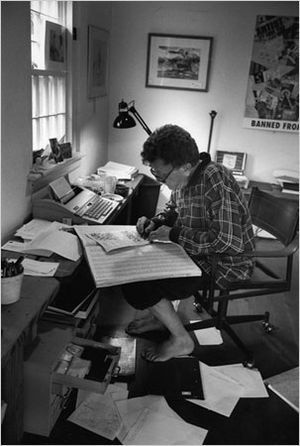 and clippings pinned to the walls, the notebooks full
and clippings pinned to the walls, the notebooks full
of barely-readable scribbles, the smells of ink, old books and
half-drunk cups of tea. The fact that much of a writer's work is
invisible to the eye makes these work spaces more interesting to me, not
less; they are alchemical laboratories in which the lead of daily life
is transmuted into the gold of words upon the page.
As John Updike once wrote, the creative artist "brings something into
the world that didn't exist before, and that he does it without
destroying something else. A kind of refutation of the conservation of
matter. That still seems to me its central magic, its core of joy."
By photographing writers at their desks, Krementz manages to capture some vital essence of each author: Kurt Vonnegut disheavelled and barefoot, Eudora Welty elegant and correct, Jean Piaget hunched within a flood of papers, Nikki Giovanni with an exuberant flurry of notes and pictures pinned to the wall, E.B. White and Joan Didion in rooms as spare and calm as Shaker meeting halls.
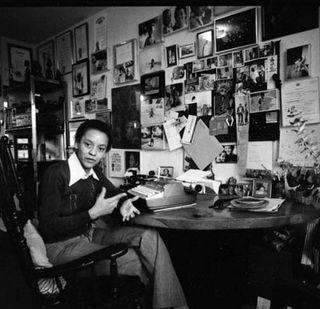 Among the many writers I've known and worked with over the years, work spaces have run the gamut -- from the spare and monastic to the crowded and museum-like, from sumptuous libraries to crumbling backyard shacks, from attic aeries to kitchen counters to tables at the local Starbucks.
Among the many writers I've known and worked with over the years, work spaces have run the gamut -- from the spare and monastic to the crowded and museum-like, from sumptuous libraries to crumbling backyard shacks, from attic aeries to kitchen counters to tables at the local Starbucks.
In my own life, I've tended to separate my writing/editing work from visual art by having separate rooms for each -- preferably a writing office in the house and a shared art studio somewhere outside it. In Tucson for many years, for example, I shared a home office with fellow-writer Ellen Steiber (author of the utterly magical novel A Rumour of Gems) and an art studio in the Tooleshed Building near Hotel Congress with Beckie Kravetz (creator of gorgeous sculptures and masks).
These days in Devon, however, both my writing office and studio are out of the house, in a Victorian office building in the village square -- and, for the first time in almost 20 years, my Writer/Editor Self and my Artist Self are obliged to share a single room. I'm not yet sure how that's going to work out. It's a good room, big and light-filled, with a fine view over the rooftops of the village shops, and decent American-style coffee available at the bookstore/cafe across the street. But my Artist Self, messy and sprawling, complains that she's feeling a bit constrained by the organized tidiness of the quieter Writer/Editor. These two are not yet good roommates, I fear. I may have to draw a line down the middle of the room to stop their bickering....
I never really did solve the problem. I got far more writing and editing done in that particular space than drawing or painting; the two sides of me didn't live easily together. I suppose I would have resolved this eventually, but the problem was solved for me when the studio of my dreams became available the next spring. Here's a post from 2010, shortly after I moved (with the help of friends and neighbors, bless them, carrying heavy studio furniture up a steep, steep hill):
As much as I loved the creative community at 42 The Square, when the opportunity came up to rent a studio space adjacent to our back garden, I couldn't resist. So I've moved once again, which I hope will be my last move for a good long while because I love it here. My workspace now is peaceful cabin resting on the slope of a hill, reached through a small gate in our back hedge. Directly behind it is a stream and small woodland, with a wild hill and farmers' fields beyond. Floor-to-ceiling windows make up one long wall, looking down on the village Commons below, with the moor rising in the distance. In front of the cabin, there's an overgrown garden, full of flowers, and a frog pond...paradise! Built of recycled wood, glass, and tin, the cabin is a long, rectangular space that is easily divided (by means of a large bookcase) into two separate rooms -- one for a writing office, and one for an art studio. It feels so good to have those two workspaces divided once again -- the office calm and tidy always, the studio exploding with paints and papers as I work.
It's the first time in a very long while that I've worked in a studio all my own, rather than in a shared or communal space. At 42 the Square, there were always others in and out...whereas here there's only Tilly and me. I'm finding a different kind of inspiration and working rhythm in solitude. Here, my daily conversations are with birds and sheep and honeybees, with stones in the creek and trees on the hill. It's not that it's a better way of working than the other, but rather that it seems to suit this phase of my creative life...and the needs of middle-age, not youth. Oh, my fingers are itching with all the things I want to write, draw, and paint in this quirky little cabin on the hill...
Okay then, girl. Deep breath. Begin.
Once upon a time....
 The black and white photographs above are all from The Writer's Desk by Jill Krementz (Random House, 1997), which I highly recommend. The writers pictured here are E.B. White, Joan Didion, Kurt Vonnegut, and Nikki Giovanni. The first of the two color images depict my former studio in the village Square. The last is of my current studio.
The black and white photographs above are all from The Writer's Desk by Jill Krementz (Random House, 1997), which I highly recommend. The writers pictured here are E.B. White, Joan Didion, Kurt Vonnegut, and Nikki Giovanni. The first of the two color images depict my former studio in the village Square. The last is of my current studio.
April 1, 2013
Happy April Fool's Day from Tilly
Moments after I pushed the button to publish the last post, I looked over at Tilly and found that she had her own comment to make for April Fool's Day. Fortunately my camera was to hand, and so I can pass her endorsement of Creative Foolishness on to all of you. What a little clown.
Terri Windling's Blog
- Terri Windling's profile
- 707 followers



